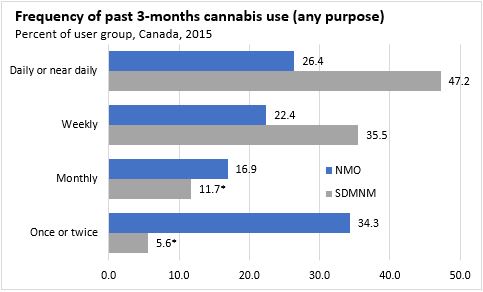The Economics and Statistics Division maintains archives of previous publications for accountability purposes, but makes no updates to keep these documents current with the latest data revisions from Statistics Canada. As a result, information in older documents may not be accurate. Please exercise caution when referring to older documents. For the latest information and historical data, please contact the individual listed to the right.
<--- Return to Archive
For additional information relating to this article, please contact:
July 24, 2018STUDY: PREVALENCE AND CORRELATES OF NON-MEDICAL ONLY COMPARED TO SELF-DEFINED MEDICAL AND NON-MEDICAL CANNABIS USE, CANADA, 2015 Statistics Canada has released the study “Prevalence and correlates of non-medical only compared to self-defined medical and non-medical cannabis use, Canada, 2015.” The study compares characteristics and use patterns of people who reported using cannabis exclusively for non-medical purposes to those who reported at least some medical use in combination with non-medical use. The study uses data from the 2015 Canadian Tobacco, Alcohol and Drugs Survey (CTADS).
The results from this study should be interpreted with caution as cannabis consumption and behaviours are self-reported and are subject to statistical bias. These results illustrate correlations between users’ characteristics and do not imply a causal relationship between cannabis use and social or economic outcomes.
According to the study, 9.5 per cent of Canadians aged 15 years and over (2.8 million) used cannabis in the previous year for non-medical only (NMO) purposes. Another 2.8 per cent (830,900) reported some cannabis use for self-defined medical and non-medical (SDMNM) purposes. In both groups, males were more likely than females to report use in the past year. The proportion of the population aged 15 and over using cannabis for either use was highest in British Columbia, where 11.8 per cent reported NMO use and 5.4 per cent reported SDMNM use.

* denotes ‘use with caution’
SDMNM use was higher among people with fair or poor general health (including mental health). NMO users were more likely to rate their general health as good, very good or excellent, while there was no statistically significant difference in self-reported mental health. Those who identified as being a daily smoker, heavy drinker, or had used other illicit drugs or other psychoactive pharmaceuticals were also more likely to report using cannabis (either for NMO or SDMNM use) in the past year.
People reporting SDMNM use and living in the lowest 20 per cent income bracket were more likely to report past year cannabis use than those with higher incomes. NMO use did not vary by income level.
The study shows that those using cannabis for SDMNM purposes are more frequent users compared to NMO users. Daily or near-daily use in the three months prior to being surveyed was reported by 47.2 per cent of SDMNM users, compared to 26.4 per cent of NMO users. Daily or near-daily use among NMO users was more common among males (31.1 per cent) than females (19.3 per cent). More than half of SDMNM users aged 25 to 44 (55.3 per cent) reported daily use compared to 32.4 per cent of NMO users in the same age bracket.

* denotes ‘use with caution’
For SDMNM users, more than half (52.5 per cent) identified pain as the primary purpose for their medical use. Another 18.8 per cent reported treating anxiety, nerves and depression, while 18.3 per cent reported use to treat insomnia, and 10.3 per cent identified other reasons.
Full report | Daily Release
Health Reports Catalogue No. 82-003-X
<--- Return to Archive